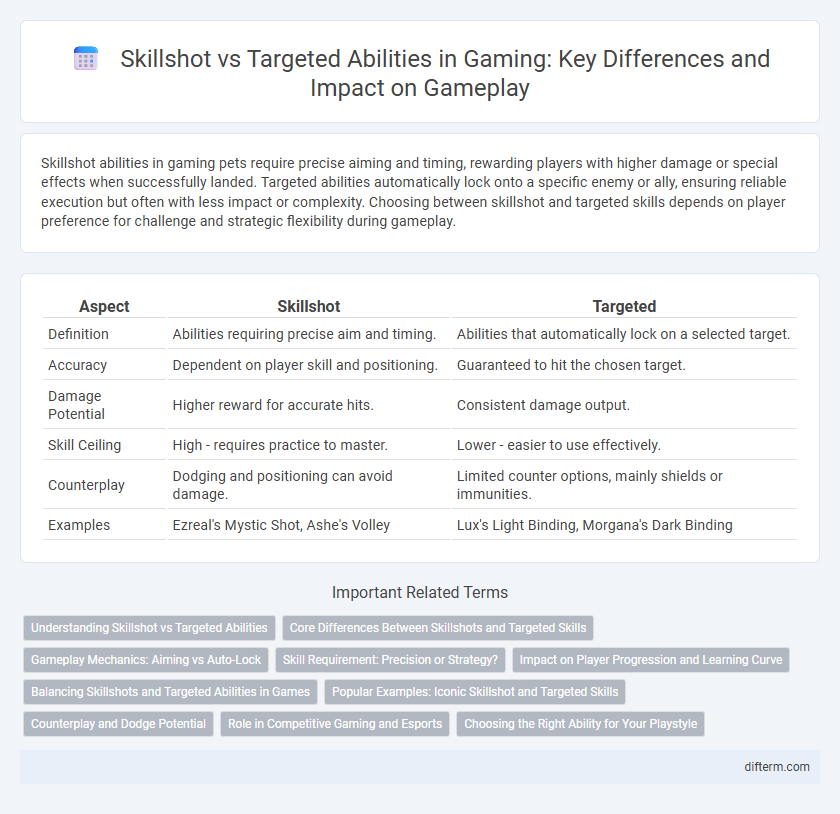Skillshot abilities in gaming pets require precise aiming and timing, rewarding players with higher damage or special effects when successfully landed. Targeted abilities automatically lock onto a specific enemy or ally, ensuring reliable execution but often with less impact or complexity. Choosing between skillshot and targeted skills depends on player preference for challenge and strategic flexibility during gameplay.
Table of Comparison
| Aspect | Skillshot | Targeted |
|---|---|---|
| Definition | Abilities requiring precise aim and timing. | Abilities that automatically lock on a selected target. |
| Accuracy | Dependent on player skill and positioning. | Guaranteed to hit the chosen target. |
| Damage Potential | Higher reward for accurate hits. | Consistent damage output. |
| Skill Ceiling | High - requires practice to master. | Lower - easier to use effectively. |
| Counterplay | Dodging and positioning can avoid damage. | Limited counter options, mainly shields or immunities. |
| Examples | Ezreal's Mystic Shot, Ashe's Volley | Lux's Light Binding, Morgana's Dark Binding |
Understanding Skillshot vs Targeted Abilities
Skillshot abilities require precise aim and timing, demanding players to predict enemy movements and positioning for effective hits, enhancing gameplay skill and engagement. Targeted abilities automatically lock onto an enemy, prioritizing accuracy and strategic use over manual precision, making them reliable in clutch situations. Understanding the strengths and weaknesses of skillshot versus targeted abilities allows players to optimize their combat tactics and improve overall performance in competitive gaming.
Core Differences Between Skillshots and Targeted Skills
Skillshots require precise aiming and timing to hit a moving or stationary target, demanding player accuracy and spatial awareness. Targeted skills automatically lock onto a specific enemy or ally, ensuring a guaranteed hit without the need for manual targeting. The core difference lies in player control and risk: skillshots offer high reward through player skill, while targeted skills provide reliability and ease of use.
Gameplay Mechanics: Aiming vs Auto-Lock
Skillshot abilities require precise aiming and timing, rewarding player skill and spatial awareness in gameplay mechanics. Targeted abilities utilize auto-lock systems that guarantee hit accuracy but reduce the need for manual precision. This contrast impacts player strategy, with skillshots offering higher risk-reward dynamics and targeted abilities favoring consistent damage output.
Skill Requirement: Precision or Strategy?
Skillshot abilities demand high precision, requiring players to accurately aim and time their attacks to hit moving or vulnerable targets, emphasizing mechanical skill and quick reflexes. Targeted abilities prioritize strategic decision-making, allowing players to select specific enemies or allies, reducing the chance of missing but increasing the importance of situational awareness and positioning. Mastery in gaming often involves balancing the precise execution of skillshots with the tactical use of targeted abilities to maximize combat effectiveness.
Impact on Player Progression and Learning Curve
Skillshot abilities demand precise timing and accuracy, which accelerates player skill development and fosters mastery through repeated practice. Targeted abilities streamline gameplay by reducing complexity, enabling faster engagement and smoother initial progression for beginners. Balancing these mechanics in game design directly influences the learning curve and long-term player retention.
Balancing Skillshots and Targeted Abilities in Games
Balancing skillshots and targeted abilities in games requires careful tuning of cooldowns, damage output, and hitbox sizes to ensure fairness and player satisfaction. Skillshots reward precision and timing, creating a higher skill ceiling, while targeted abilities offer reliability and accessibility, appealing to different player preferences. Developers must analyze data on player success rates and engagement to optimize these mechanics, maintaining competitive balance and diverse gameplay strategies.
Popular Examples: Iconic Skillshot and Targeted Skills
Skillshots, such as Ezreal's Mystic Shot in League of Legends or Hanzo's Sonic Arrow in Overwatch, require precise aiming and timing, rewarding player skill and positioning. Targeted skills, like Katarina's Death Lotus or Amumu's Curse of the Sad Mummy, automatically lock onto opponents, emphasizing strategic use rather than accuracy. Iconic skillshots combine risk and reward by demanding high precision, while targeted skills excel in guaranteed impact during team fights or crowd control scenarios.
Counterplay and Dodge Potential
Skillshot abilities require precise aiming and timing, creating opportunities for opponents to predict and dodge, thus increasing counterplay potential. Targeted abilities lock onto a specific enemy, reducing dodge options but often allowing for strategic timing and positional counterplay. Effective gameplay balances the risk of missing skillshots with the inevitability of targeted strikes, emphasizing player awareness and reflexes.
Role in Competitive Gaming and Esports
Skillshot abilities require precise player timing and aim, rewarding mechanical skill and spatial awareness in competitive gaming. Targeted abilities ensure higher reliability and strategic consistency, allowing players to focus on positioning and game sense in esports environments. Balancing both types of skills is essential for team composition and effective in-game decision-making.
Choosing the Right Ability for Your Playstyle
Skillshot abilities require precise aim and timing, rewarding players who excel at prediction and positioning with high-impact damage or crowd control. Targeted abilities automatically lock onto enemies, favoring a playstyle that prioritizes reliability and consistency over mechanical skill. Choosing between skillshot and targeted abilities depends on whether you prefer dynamic, high-risk plays or steady, guaranteed effects in your gaming strategy.
Skillshot vs Targeted Infographic

 difterm.com
difterm.com